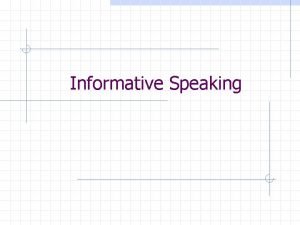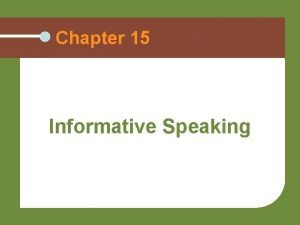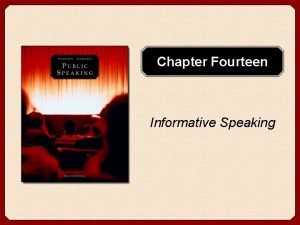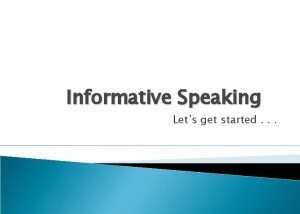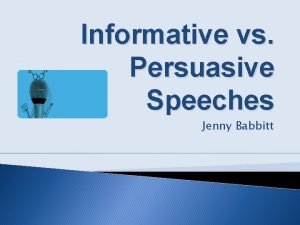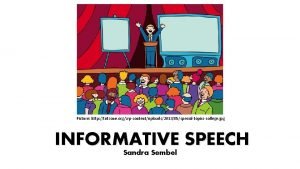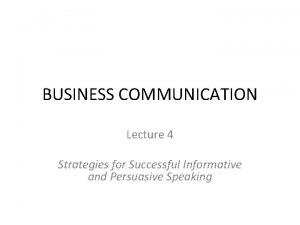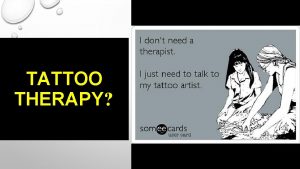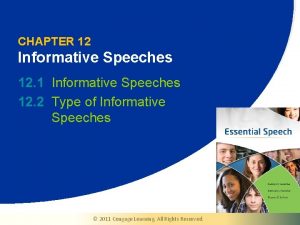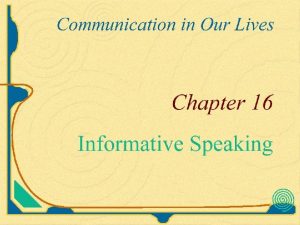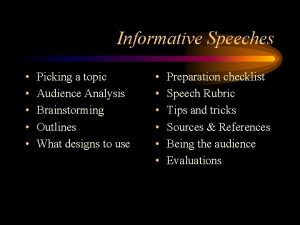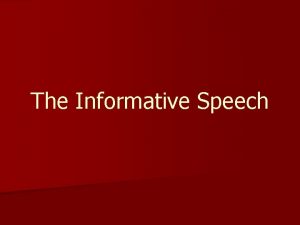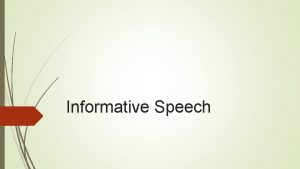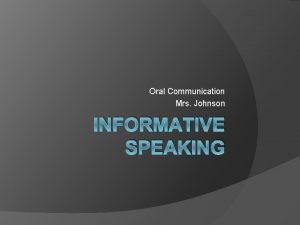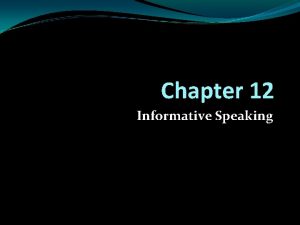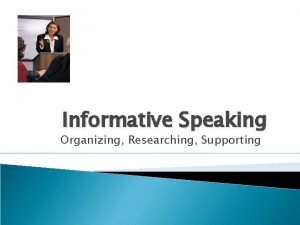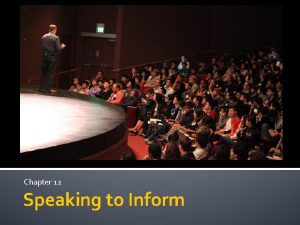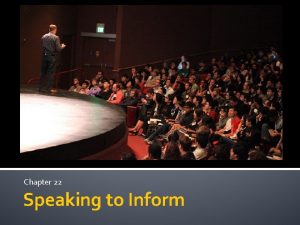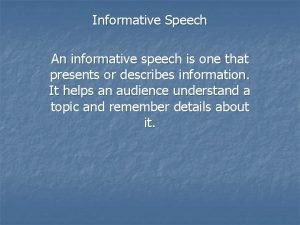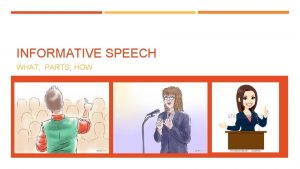INFORMATIVE SPEAKING A speech to inform presents the
















- Slides: 16

INFORMATIVE SPEAKING A speech to inform presents the facts in an objective way.

Your goal as an informative speaker: � Share facts about your topic you have learned through experience, observation, listening, and reading (research). � You must be accurate and clear

The six C’s of Informative Speaking: � Be clear-Is my speech so clear that everyone will understand? � Be concise-Is my speech so concise that no one’s time will be wasted? � Be complete-Is my speech complete in covering the necessary and appropriate information?

The six C’s of Informative Speaking Continued… � Be correct-Am I confident that my information is absolutely correct? � Be concrete-Have I provided concrete examples so that the audience can see my point? � Connect-Can I connect my speech with what I know about my audience?

Planning your Informative Speech � The first step is to decide an appropriate topic. Remember that an informative speech does not advocate a political position, cause, way of thinking or action to take. Think of yourself as a teacher who will be simply presenting the facts in an objective way. Choose something which interests you. Something you know about or want to research.

Step 2: Classification of Topic � Next, you should decide on how you would classify your speech. Most informative speeches are divided into four categories: � (1) speeches about events � (2) speeches about a person, place or thing. � (3) speeches about concepts. � (4) speeches about processes.

Step 3: Identify what your goal is. Once you decide on the category, you must then develop your specific purpose. � A "speaker-centered" or "audiencecentered. " speech. � If it is speaker-centered, then your specific purpose will usually begin as, "To inform my audience about. . . “ � An audience-centered speech typically begins, "At the end of my speech, I want my audience to. . . " �

Why develop a Goal? � Determining your specific purpose is important since it will guide you during the speech writing process so that you stay focused on what you hope to accomplish with the speech. � It will ensure that you do not stray too far off the topic and discuss irrelevant material that will make your CM message less clear.

4 ways to organize your speech: Chronological order -you talk about incidents in the order that they actually occurred. � Causal order- The most common format of causal order is to go from speaking about the cause first, and then moving to the effect. � Topical order-you can talk about event aspects in any logical order. � Spatial order- This is most common if you are describing a region on a map. Here, you might discuss the north part first, then the south, and finally talk about the east and west portions of a geographic region. �

Step 4: How will you order your speech? � It is now time to begin your outline. How you organize your outline will depend on your speech's classification. ~If it is a speech on an event, you could use a "chronological" order � If your specific purpose pertains to showing how some event led to something, then you could use a "causal" order. � A third option is choosing a "topical" order- An example of when you would use topical would be if you chose to inform your audience about the many events in a high school track meet (pole vault, 100 meter dash, etc. ).

Choosing appropriate order for your speech continued…. . ~If your speech is about a person place or thing, then you can adapt a "topical" or "chronological” order. � An informative speech about an object tends to use a "spatial" order. Your focus may be describing Rocky Mountain High School. You might start with describing the west side of the school, moving to the north side, east side, and completing the “tour” with the southern region of the campus. �

� ~If you choose to give an informative speech over a concept, then your order choice is rather limited. Most speakers will choose the "topical" order since you want to precisely spell out the main aspects and characteristics of your concept.

� If you choose an informative speech on a process, then your choices are generally limited to the orders of either "chronological" or "topical. "

Step 5: Sources, sources. (Credibility) Always utilize external sources in order to back-up your central idea and main points. � Always verbally cite these sources and include the sources in any Power. Point slides you may use while you are presenting. � Remember, it is important to have **credibility in whatever setting you are giving an informative speech. Sorry kidos**Wikipedia is NOT a credible source!!!! �

Step 6: Don't forget basic speech organization � Introduction: Attention getter, Motivational link, Thesis, Preview, Transition into body of speech. � Body: Point 1, Transition, Point 2, Transition, Point 3, Transition to conclusion. � Conclusion… Review, Action statement, Wrap-up.

INFORM BRAINSTORM +12 PTS � � � For each of the 4 informative speech topic categories, 1. Event 2. Person/Place/Thing 3. Concept 4. Process brainstorm at least 6 topic ideas for EACH category. Example: A topic idea which would fit under the Event category would be Hurricane Katrina. Person. Taylor Swift. Concept- telephone (think inventions) and Process-How cheese is made.
 Persuasive speech vs informative speech
Persuasive speech vs informative speech Informative vs persuasive
Informative vs persuasive Characteristics of effective informative speaking
Characteristics of effective informative speaking Guidelines for informative speaking
Guidelines for informative speaking What is the essence of informative speaking?
What is the essence of informative speaking? Uil extemp topics
Uil extemp topics Informative or expository speech
Informative or expository speech Informative vs persuasive
Informative vs persuasive Informative speech
Informative speech Informative speech strategies
Informative speech strategies Reported speech persuade
Reported speech persuade Informative communication strategies
Informative communication strategies Informative speech examples
Informative speech examples Speech therapy tattoos
Speech therapy tattoos Informative speech characteristics
Informative speech characteristics Specific purpose statement for an informative speech
Specific purpose statement for an informative speech Audience analysis example for informative speech
Audience analysis example for informative speech
